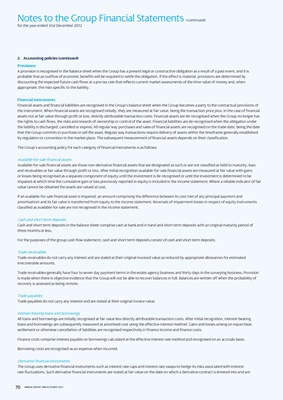
Notes to the Group Financial Statements (continued)
for the year ended 31st December 2012
2. Accounting policies (continued)
Provisions
A provision is recognised in the balance sheet when the Group has a present legal or constructive obligation as a result of a past event, and it is
probable that an outflow of economic benefits will be required to settle the obligation. If the effect is material, provisions are determined by
discounting the expected future cash flows at a pre-tax rate that reflects current market assessments of the time value of money and, when
appropriate, the risks specific to the liability.
Financial instruments
Financial assets and financial liabilities are recognised in the Group’s balance sheet when the Group becomes a party to the contractual provisions of
the instrument. When financial assets are recognised initially, they are measured at fair value, being the transaction price plus, in the case of financial
assets not at fair value through profit or loss, directly attributable transaction costs. Financial assets are de-recognised when the Group no longer has
the rights to cash flows, the risks and rewards of ownership or control of the asset. Financial liabilities are de-recognised when the obligation under
the liability is discharged, cancelled or expires. All regular way purchases and sales of financial assets are recognised on the trade date, being the date
that the Group commits to purchase or sell the asset. Regular way transactions require delivery of assets within the timeframe generally established
by regulation or convention in the market place. The subsequent measurement of financial assets depends on their classification.
The Group’s accounting policy for each category of financial instruments is as follows:
Available-for-sale financial assets
Available-for-sale financial assets are those non-derivative financial assets that are designated as such or are not classified as held to maturity, loan
and receivables or fair value through profit or loss. After initial recognition available-for-sale financial assets are measured at fair value with gains
or losses being recognised as a separate component of equity until the investment is de-recognised or until the investment is determined to be
impaired at which time the cumulative gain or loss previously reported in equity is included in the income statement. Where a reliable indicator of fair
value cannot be obtained the assets are valued at cost.
If an available-for-sale financial asset is impaired, an amount comprising the difference between its cost (net of any principal payment and
amortisation) and its fair value is transferred from equity to the income statement. Reversals of impairment losses in respect of equity instruments
classified as available-for-sale are not recognised in the income statement.
Cash and short term deposits
Cash and short term deposits in the balance sheet comprise cash at bank and in hand and short term deposits with an original maturity period of
three months or less.
For the purposes of the group cash flow statement, cash and short term deposits consist of cash and short term deposits.
Trade receivables
Trade receivables do not carry any interest and are stated at their original invoiced value as reduced by appropriate allowances for estimated
irrecoverable amounts.
Trade receivables generally have four to seven day payment terms in the estate agency business and thirty days in the surveying business. Provision
is made when there is objective evidence that the Group will not be able to recover balances in full. Balances are written off when the probability of
recovery is assessed as being remote.
Trade payables
Trade payables do not carry any interest and are stated at their original invoice value.
Interest bearing loans and borrowings
All loans and borrowings are initially recognised at fair value less directly attributable transaction costs. After initial recognition, interest-bearing
loans and borrowings are subsequently measured at amortised cost using the effective interest method. Gains and losses arising on repurchase,
settlement or otherwise cancellation of liabilities are recognised respectively in finance income and finance costs.
Finance costs comprise interest payable on borrowings calculated at the effective interest rate method and recognised on an accruals basis.
Borrowing costs are recognised as an expense when incurred.
Derivative financial instruments
The Group uses derivative financial instruments such as interest rate caps and interest rate swaps to hedge its risks associated with interest
rate fluctuations. Such derivative financial instruments are stated at fair value on the date on which a derivative contract is entered into and are
70 ANNUAL REPORT AND ACCOUNTS 2012